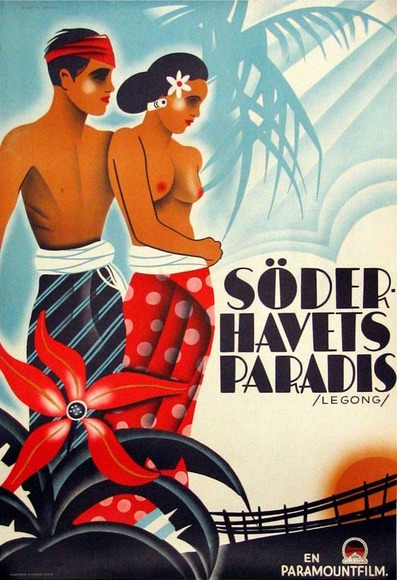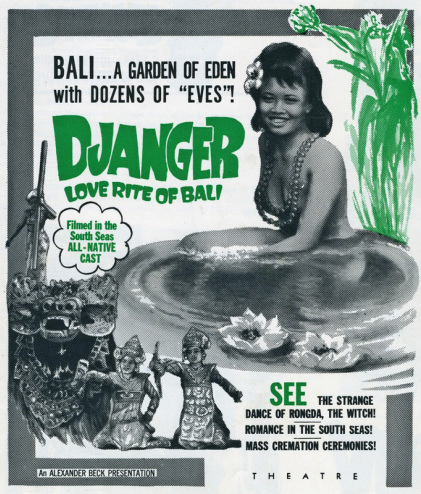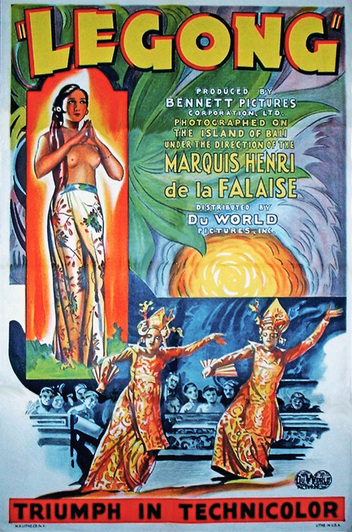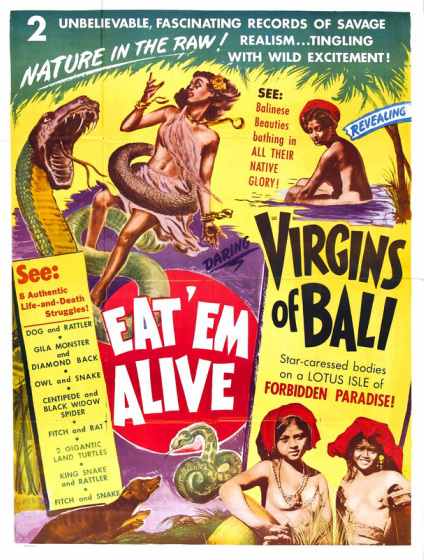Ethnographic cinema has always been viewed with suspicion by the cautious because the imperatives of the filmmakers almost inevitably influence their perception of the subjects. The results are often more "cinema" than "verité." Further complicating this already compromised view of other cultures are the methods in which a popular art form, the movies, are marketed to the public. Despite the ethnographic filmmakers' best intentions, their works have frequently been associated with advertising that highlighted the most sensationalistic aspects of cultural differences. One need only look at the "mondo" genre of films to note that their brief popularity was based not on commonality of cultures but on the most excessive of differences, whether real or fabricated.

A role that ethnographic films have consistently played in the Western marketplace is as a sort of cinematic "Trojan horse," a method to depict behavior or standards of dress that would not be permissible in a domestic production but are granted lenience from the censors for their supposed educational value.
Such is the case with a series of pseudo-documentary films made in Bali from the silent era to the 1940s. The primary selling point for these films was the island's female inhabitants, whose custom was to appear in public with their breasts exposed. As with Robert Flaherty's Nanook of the North (1922) and Merian C. Cooper and Ernest B. Schoedsack's Chang: A Drama of the Wilderness (1927), most of these films were scripted melodramas augmented with scenes of actual customs and ceremonies.
Though not the first, the most notorious of these, Armand Denis and André Roosevelt's 1932 feature Kriss, the Sword of Death (later given the better-known title Goona Goona), popularized the term "goona goona" as a salacious buzzword of the thirties and forties, and set the tone for films to follow. Denis, who subsequently made a career of ethnographic exploitation along with showmen such as Frank "Bring 'Em Back Alive" Buck, shot the film in two-strip Technicolor. After its initial engagement, the film played the grindhouse circuit for years.
Also filmed in two-color Technicolor was Legong: Dance of the Virgins (1935), one of the last features to be made using that process and also one of the last silent films to be released by a major studio in the U.S. Despite its lack of a synchronized soundtrack, Legong enjoyed an extended run with multiple reissues throughout the following decades. As evidenced by Milestone Video's current DVD release, a large part of its appeal, aside from the topless women, may have been the stunning two-strip color cinematography of W. Howard Greene, an early Technicolor specialist. Mid-century audiences also likely responded to the tragic love story that comprises the plot, which incorporates Balinese cultural practices into the melodramatic proceedings.
Such is the case with a series of pseudo-documentary films made in Bali from the silent era to the 1940s. The primary selling point for these films was the island's female inhabitants, whose custom was to appear in public with their breasts exposed. As with Robert Flaherty's Nanook of the North (1922) and Merian C. Cooper and Ernest B. Schoedsack's Chang: A Drama of the Wilderness (1927), most of these films were scripted melodramas augmented with scenes of actual customs and ceremonies.
Though not the first, the most notorious of these, Armand Denis and André Roosevelt's 1932 feature Kriss, the Sword of Death (later given the better-known title Goona Goona), popularized the term "goona goona" as a salacious buzzword of the thirties and forties, and set the tone for films to follow. Denis, who subsequently made a career of ethnographic exploitation along with showmen such as Frank "Bring 'Em Back Alive" Buck, shot the film in two-strip Technicolor. After its initial engagement, the film played the grindhouse circuit for years.
Also filmed in two-color Technicolor was Legong: Dance of the Virgins (1935), one of the last features to be made using that process and also one of the last silent films to be released by a major studio in the U.S. Despite its lack of a synchronized soundtrack, Legong enjoyed an extended run with multiple reissues throughout the following decades. As evidenced by Milestone Video's current DVD release, a large part of its appeal, aside from the topless women, may have been the stunning two-strip color cinematography of W. Howard Greene, an early Technicolor specialist. Mid-century audiences also likely responded to the tragic love story that comprises the plot, which incorporates Balinese cultural practices into the melodramatic proceedings.

Teenager Poutou (Goesti Poetoe Aloes) and her younger sister Saplak (Njoman Saplak) are dancers who perform the legong, the dance of the virgins, at their sacred temple in Tampaksiring. The girls live with their father, Bagus (Goesti Bagus Maura), whose passion is the breeding of fighting cocks.
At a temple feast, Poutou meets Njong (Njoman Nyong), a young gamelan musician, and promptly falls in love with him. She makes plans to perform her last temple dance, which customarily signals a girl's betrothal. But the fickle Njong falls for the younger Saplak, which sets in motion the dire local prophecy that disgrace will befall women whose love is unrequited.
Despite its simplicity, this thin plot incorporates not only the legong itself, but also a gamelan performance, the ceremony of the Barong and Rangda dance that signifies the battle between good and evil, and the spectacle of Balinese funeral pyres. At a time when travel to Indonesia was reserved for only the most hardy of tourists, these scenes were no doubt unheralded in their exoticism and strengthened by the naturalistic acting of the native cast. For contemporary viewers, Legong is a delicately wrought window into a unique culture that western influence has since corrupted. The crass hustle and bustle of Kuta Beach could not be further away.
At a temple feast, Poutou meets Njong (Njoman Nyong), a young gamelan musician, and promptly falls in love with him. She makes plans to perform her last temple dance, which customarily signals a girl's betrothal. But the fickle Njong falls for the younger Saplak, which sets in motion the dire local prophecy that disgrace will befall women whose love is unrequited.
Despite its simplicity, this thin plot incorporates not only the legong itself, but also a gamelan performance, the ceremony of the Barong and Rangda dance that signifies the battle between good and evil, and the spectacle of Balinese funeral pyres. At a time when travel to Indonesia was reserved for only the most hardy of tourists, these scenes were no doubt unheralded in their exoticism and strengthened by the naturalistic acting of the native cast. For contemporary viewers, Legong is a delicately wrought window into a unique culture that western influence has since corrupted. The crass hustle and bustle of Kuta Beach could not be further away.

The print of Legong presented by Milestone Film and Video was preserved by the UCLA Film and Television Archive from three separate surviving prints. When Legong was originally distributed in the U.S., all close-ups of its topless female actors were removed. In the U.K., those scenes were left intact but a segment featuring a cockfight was excised. Thanks to the efforts of the UCLA Archive, the film is once again complete as originally intended.
Legong was directed and produced by the Marquis Henri de la Falaise de la Coudraye, a reportedly dashing WWI war hero once married to Hollywood legend Gloria Swanson. The Marquis' second wife, film star Constance Bennett, financed five films for him, including Legong and the two-strip Technicolor feature Kliou the Killer filmed in Vietnam. Though the original two-strip Technicolor version of Kliou the Killer has been lost to the ages, a surviving black and white print is included as an extra on Milestone Video's release of Legong. Also included is Nikola Drakulic's 56 minute documentary Gods of Bali (1952), which bypasses melodramatics to present an explanatory, if less poetic, interpretation of Balinese rites and customs. An alternate soundtrack by the contemporary group Gamelan Sekar Jaya is also provided for the main feature, and is preferable to the film's mawkish original score.
Because of its display of post-pubescent nudity, Legong was fair bounty for the exploitation trade. In addition to numerous roadshow presentations under its original title, the film was reissued in the sixties by New York film distributor Alexander Beck as Djanger, Love Rite of Bali with the tagline "Nudity Without Crudity." Beck's strategy was as transparent as Kroger Babb's infamous retitling of Ingmar Bergman's Summer With Monica (1953) as Monika, the Story of a Bad Girl. With the lyrical, picturesque Legong, crudity is in the eye of the beholder.
Legong was directed and produced by the Marquis Henri de la Falaise de la Coudraye, a reportedly dashing WWI war hero once married to Hollywood legend Gloria Swanson. The Marquis' second wife, film star Constance Bennett, financed five films for him, including Legong and the two-strip Technicolor feature Kliou the Killer filmed in Vietnam. Though the original two-strip Technicolor version of Kliou the Killer has been lost to the ages, a surviving black and white print is included as an extra on Milestone Video's release of Legong. Also included is Nikola Drakulic's 56 minute documentary Gods of Bali (1952), which bypasses melodramatics to present an explanatory, if less poetic, interpretation of Balinese rites and customs. An alternate soundtrack by the contemporary group Gamelan Sekar Jaya is also provided for the main feature, and is preferable to the film's mawkish original score.
Because of its display of post-pubescent nudity, Legong was fair bounty for the exploitation trade. In addition to numerous roadshow presentations under its original title, the film was reissued in the sixties by New York film distributor Alexander Beck as Djanger, Love Rite of Bali with the tagline "Nudity Without Crudity." Beck's strategy was as transparent as Kroger Babb's infamous retitling of Ingmar Bergman's Summer With Monica (1953) as Monika, the Story of a Bad Girl. With the lyrical, picturesque Legong, crudity is in the eye of the beholder.

Not so with the pandering B&W sound production Virgins of Bali (1932), filmmaker Deane H. Dickason's paean to the ogling of teenage breasts. Though Virgins also weaves aspects of Balinese custom into its tale of two sisters, the twelve-year old Tagel (Ni Wayan Tagel) and her sixteen-year-old sister Grio (Ni Wayan Ugembon), the Gamelan and temple rites of Legong are but briefly glimpsed. Instead, Dickason revels in scenes presenting the two girls as they "bathe their shamelessly nude, bronze bodies in the refreshing though murky waters" of the village stream.
Ostensibly the story of the elder sister's elopement with former temple dancer Kaler (T. Kaler), Virgins of Bali appears most interested in finding successive reasons to display the unclad torsos of its "naive" teenage subjects, often accompanied by tasteless commentary from narrator Dickason. A scene of the two teens massaging their skin with coconut oil as protection from the harsh rays of the equatorial sun inspires Dickason to knowingly warn, "young men, mark my words: that Bali oil leaves telltale stains in twice as many places as any face powder." The cynical, colonialist commentaries of the "mondo" genre loom large in the distance.
As with Legong, the creepy Virgins of Bali was prodigiously re-released for decades following its initial run. A sad indicator of its sorry pedigree is the tawdry company it was forced to keep: one engagement paired it in support of Eat 'Em Alive (1933) a feature-length film about animals eating one another. Though Dickason enthuses about Bali as a "utopia," his film trivializes and cheapens Indonesian culture by catering to the base appetites of the roadshow circuit. Seen today, it's a rank reminder of the sexual tourism of pederasts.
Alpha Video's budget DVD release of Virgins of Bali, now a property of Independent-International Pictures of Al Adamson infamy, includes as an extra the thirty-minute documentary Bali, Paradise Island (1930), one of Eugene W. Castle's "World Parade" travelogues once licensed for home projection through his Castle Films outfit. Also included is the campy 1940 featurette Beauty in Bali, a presentation of the Bali Bra Company (formerly the Fay-Miss Brassiere Company), which opens with footage from Virgins of Bali accompanied by snooty commentary from an uncredited female narrator. What follows is a full-color tour of the company's brassiere factory, concluding with bogus case studies of seven women whose physical challenges are solved by products from the Bali line of undergarments. It's as tasteful as you'd expect.
Ostensibly the story of the elder sister's elopement with former temple dancer Kaler (T. Kaler), Virgins of Bali appears most interested in finding successive reasons to display the unclad torsos of its "naive" teenage subjects, often accompanied by tasteless commentary from narrator Dickason. A scene of the two teens massaging their skin with coconut oil as protection from the harsh rays of the equatorial sun inspires Dickason to knowingly warn, "young men, mark my words: that Bali oil leaves telltale stains in twice as many places as any face powder." The cynical, colonialist commentaries of the "mondo" genre loom large in the distance.
As with Legong, the creepy Virgins of Bali was prodigiously re-released for decades following its initial run. A sad indicator of its sorry pedigree is the tawdry company it was forced to keep: one engagement paired it in support of Eat 'Em Alive (1933) a feature-length film about animals eating one another. Though Dickason enthuses about Bali as a "utopia," his film trivializes and cheapens Indonesian culture by catering to the base appetites of the roadshow circuit. Seen today, it's a rank reminder of the sexual tourism of pederasts.
Alpha Video's budget DVD release of Virgins of Bali, now a property of Independent-International Pictures of Al Adamson infamy, includes as an extra the thirty-minute documentary Bali, Paradise Island (1930), one of Eugene W. Castle's "World Parade" travelogues once licensed for home projection through his Castle Films outfit. Also included is the campy 1940 featurette Beauty in Bali, a presentation of the Bali Bra Company (formerly the Fay-Miss Brassiere Company), which opens with footage from Virgins of Bali accompanied by snooty commentary from an uncredited female narrator. What follows is a full-color tour of the company's brassiere factory, concluding with bogus case studies of seven women whose physical challenges are solved by products from the Bali line of undergarments. It's as tasteful as you'd expect.
New reviews this edition: Blue Ruin (2013), Five Artists: BillBobBillBillBob (1971), Murder In Mississippi (1965), and The Black Rebels (1965). Added to the archive is The Love Butcher (1975).
 RSS Feed
RSS Feed